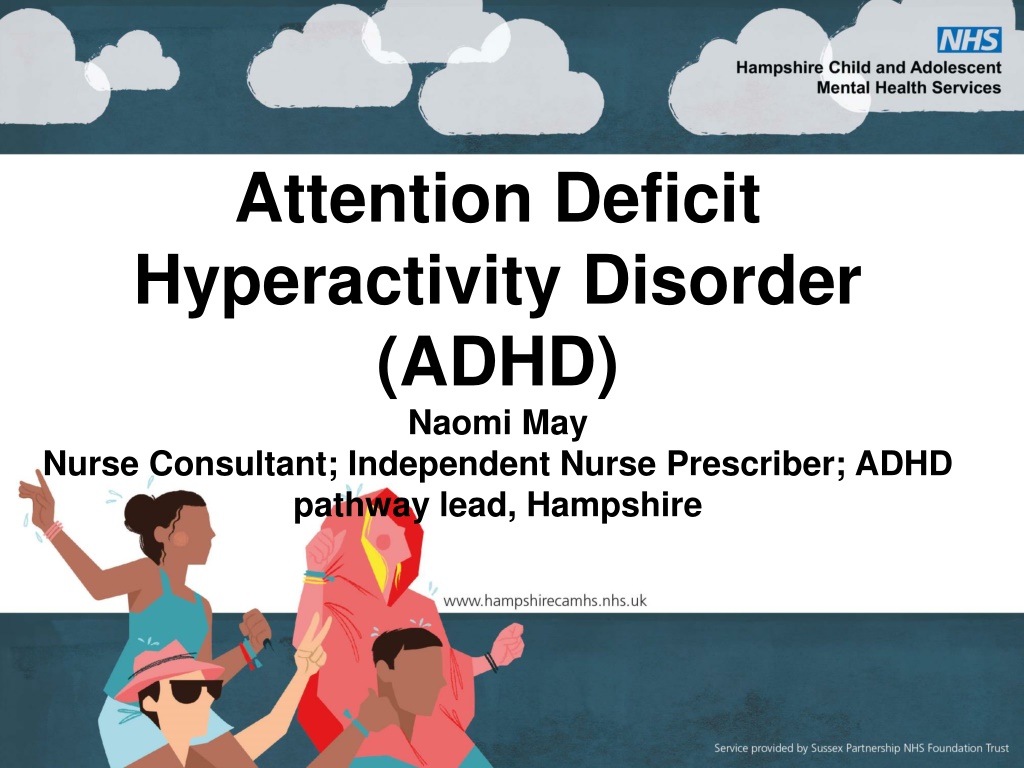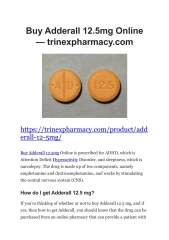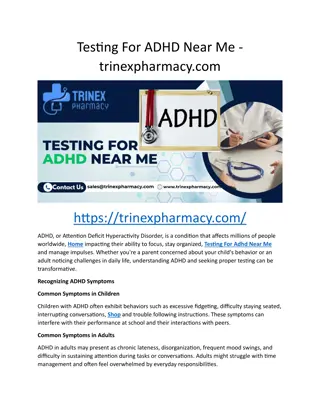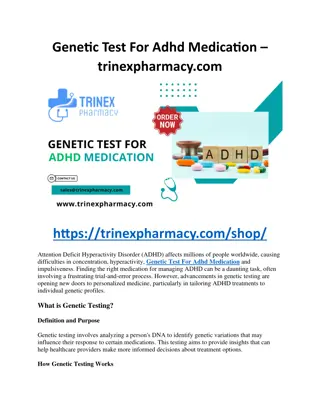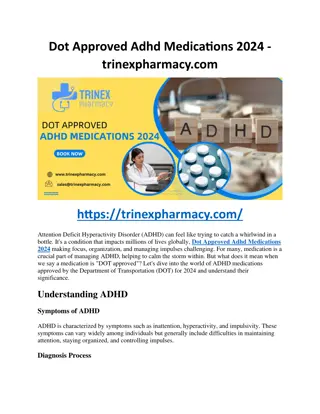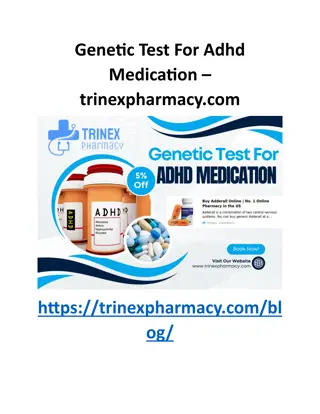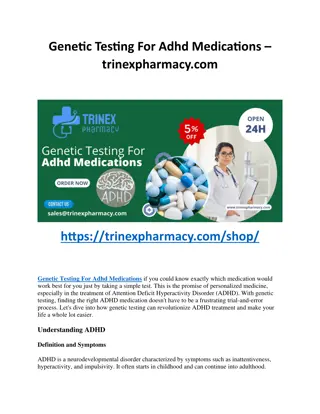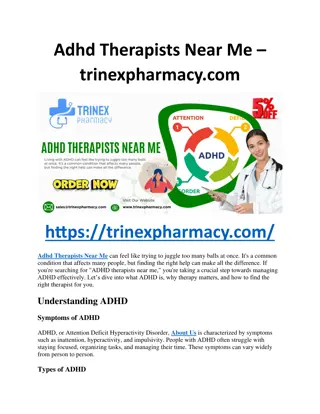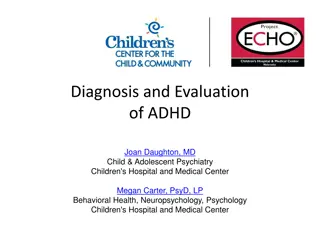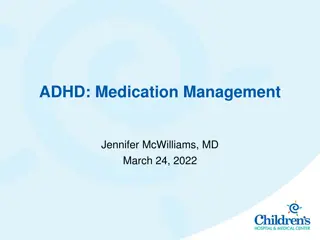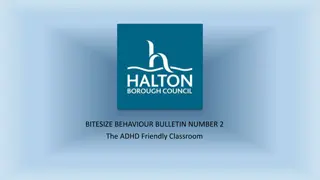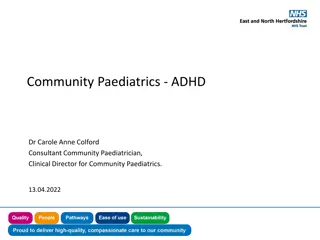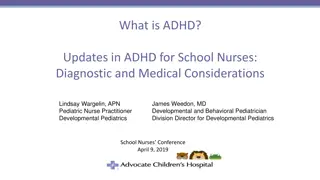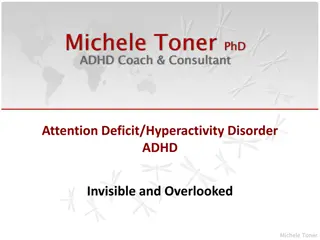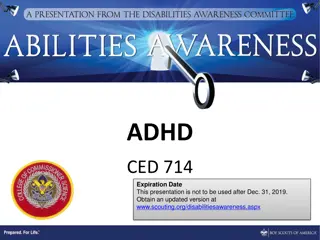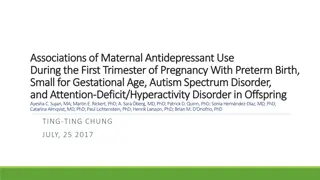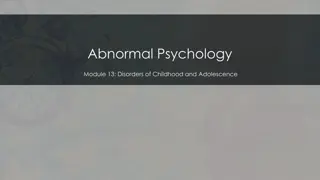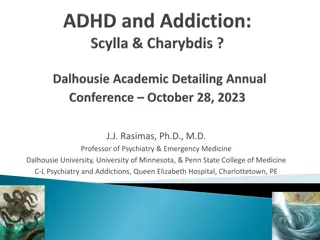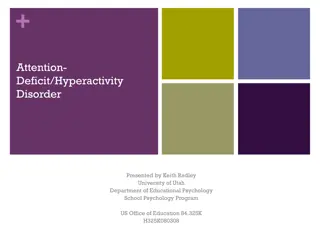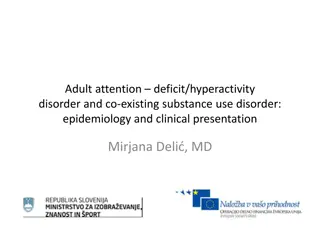Understanding Attention Deficit Hyperactivity Disorder (ADHD)
ADHD is a common neurodevelopmental disorder affecting attention, activity levels, and impulse control. It manifests in different subtypes and can be spotted in children before the age of 6. Symptoms persist across contexts and should cause impairment in social, academic, or occupational areas. Genetic and environmental factors play a role, and famous individuals with ADHD prove that it doesn't define one's success.
Download Presentation

Please find below an Image/Link to download the presentation.
The content on the website is provided AS IS for your information and personal use only. It may not be sold, licensed, or shared on other websites without obtaining consent from the author. Download presentation by click this link. If you encounter any issues during the download, it is possible that the publisher has removed the file from their server.
E N D
Presentation Transcript
Attention Deficit Hyperactivity Disorder (ADHD) Naomi May Nurse Consultant; Independent Nurse Prescriber; ADHD pathway lead, Hampshire
Objectives: What is ADHD Managing ADHD
Attention Deficit Hyperactivity Disorder Is a common, lifelong, neurodevelopmental disorder that affects a persons ability to focus attention, regulate activity levels and control their impulses Three subtypes: 1) ADHD combined type 2) ADHD predominantly inattentive type 3) ADHD predominantly hyperactive-impulsive type.
A better way to think about it? Kids with ADHD are relatively brakeless. They are: Unable to put the brakes on distraction inattention Unable to put the brakes on inside thoughts impulsive Unable to put the brakes on acting upon distractions or thoughts hyperactivity
In the UK its thought that 3-5% of school aged children have ADHD (NHS England) Minor difference in chemical tuning of the brain. Commonly genetic, environment can make symptoms worse Tend to notice signs before the age of 6, behaviour must be more severe than other young people in the same age group. The symptoms above cause significant distress or impairment in social, academic or occupational functioning Symptoms present >6 months, across two different contexts for example, school and home, day care and friendships.
Inattention Overactivity Impulsivity Fails to give close attention to detail Unable to sit still for as long as peers Difficulties taking turns, may interrupt Easily distracted by external stimuli Often up and out of seat Can not wait in a line Easily off task from one thing to another - changes Runs and climbs when inappropriate Talkative Makes careless mistakes Fidgety with hands and feet Unable to engage in play quietly Has difficulties listening when spoken to Is often on the go Premature or thoughtless actions Inability to follow instructions Restless and shifting excess of movement Unable to complete tasks Difficulties with organisational skills Avoids tasks that require mental effort Often loses items required Forgetful in daily activities Disorganised
Symptoms of ADHD are associated with having lower levels of the brain chemicals dopamine and noradrenaline in the brain. Dopamine carries signals between nerves in the brain and is linked to movement, sleep, mood, attention, and learning, motivation, reward and cognition, Certain parts of the brain may be less active or smaller in children with ADHD.
Noradrenaline is linked to memory, alertness and learning These chemicals promotes feelings of enjoyment and reinforcement to motivate performance . When we are deficient, it makes learning very difficult. That feeling of accomplishment when we learn something new simply isn t there
What else could it be? Obsessive Compulsive Disorder Oppositional Defiant Disorder Conduct Disorder Bi Polar Dyslexia Dyspraxia Tics/Tourette's Autistic Spectrum Condition Attachment difficulties Irlen Syndrome Anxiety Speech and Language Disorder Sleep Disorder Substance Misuse Behavioural Sensory Processing Disorder Auditory Processing Disorder Trauma Developmental Delay Chromosomal Abnormalities Epilepsy
Management First line are non medication measures. Parent training programme (Barnardo s) and behavioural management Attention training Behavioural programmes at school
Medication Following treatment with a parent training /education programme, children and young people with ADHD and persisting significant impairment could be offered medication treatment to improve concentration and reduce hyperactivity and impulsivity Overwhelming evidence for stimulants Prescription stimulants slowly increase the level of dopamine, similar to the way it s naturally produced in the brain. A prescriber will usually prescribe a low dose of a stimulant and increase it gradually if necessary.
Recognition Recognition of difficulty- parent, teacher, Teaching Assistant, SENCo, Educational Psychology Influenced by expertise - knowledge about ADHD and how it presents in both girls and boys Advice on seeking referral or assessment Managing and supporting child throughout the process Additional provision with or without diagnosis/medication
Managing ADHD behaviour Can be reactive rather than proactive Needs time, ability to focus on individual Communication and positive relationships between family and school Key relationships with class teacher and SENCo can be very beneficial
Parents can be overwhelmed by process of diagnosis and assessment as well as receiving regular (negative) feedback from school When the right fit is found, a school that can adapt around the child s needs to keep them in the classroom, experiences become much more positive
Play Why adapt your parenting style? Let them choose what to play Don t forget their developmental level It s not a competition- you don t have to win Make it fun- laugh Encourage creativity Let them solve problems without too much help Tell them how much you enjoyed it Reward the kind of play you want with your attention The environment people are in and they experiences they have can have an impact on their behaviour, and the effect this has on those around them. Parenting is one way that children can be supported to minimise the impacts their difficulties are having on themselves and those around them. Also applies to education staff. Think about the way you were parented
Play Let them choose what to play Don t forget their developmental level It s not a competition- you don t have to win Make it fun- laugh Encourage creativity Let them solve problems without too much help Tell them how much you enjoyed it Reward the kind of play you want with your attention What is the evidence about what works? Consider what is the function of the behaviour? Consequence-based Classroom: behaviour strategies such as Daily report cards token economies labelled praise effective commands and requests planned ignoring- used more intensively than for other students as those with ADHD often have a lot of (negative) corrective feedback
Play Let them choose what to play Don t forget their developmental level It s not a competition- you don t have to win Make it fun- laugh Encourage creativity Let them solve problems without too much help Tell them how much you enjoyed it Reward the kind of play you want with your attention What is the evidence about what works? Academic skills interventions Organisation skills training, time management (especially for adolescents) Homework support Training adaptive skills (e.g. note taking, social skills)
Play Let them choose what to play Don t forget their developmental level It s not a competition- you don t have to win Make it fun- laugh Encourage creativity Let them solve problems without too much help Tell them how much you enjoyed it Reward the kind of play you want with your attention Encouraging appropriate classroom behaviour, increasing study skills, helping students to work with peers Using physical activity: movement breaks, lots of opportunities/reasons to get up Rewards? (delay aversion, smaller-sooner) Engaging individual interests Academic work that is appropriately challenging but can be completed, need to achieve things
Classroom Accommodations Classroom Setup Sit away from distractions front and centre of classroom Utilise positive role models Increase distance between desks Assignments Allow extra time Break long assignments into smaller parts, shorten work periods Pairing written instructions with oral instructions
And more: Organization /Planning Recommend binders / dividers and colour coded folders Provide assignment book and supervise writing down of assignments Allow student to keeps sets of books / resources at home Allow student to run errands or stand at times Provide short breaks Moods / Socialization Set up social behaviour goals with student and implement reward program Encourage cooperative learning tasks Assign special responsibilities to student in presence of peer group Compliment positive behaviour and work give opportunity for leadership roles Frequent acknowledgment of appropriate behaviours Encourage student to walk away from angering situations
Continued Distractibility Provide peer assistance in note taking and ask student questions to encourage participation Involve student in lesson preparation Cuing student to stay on task with private signal Scheduling 5 minute period to check work prior to handing in Behaviour Ignore minor inappropriate behaviours Increase immediacy of rewards and consequences Acknowledge correct answers only when hand is raised and student is called upon Send daily /weekly progress reports home Set up achievable behaviour contract
Helpful Daily Techniques Communication can be helped by: Get their attention Eye contact Non-verbal cues Facial Expression Give advanced notice to transitions Give two choices An indirect approach often succeeds Frequent praise
EXPRESSION! Try to use facial expressions and gestures when speaking to your child; this emphasises what you are saying and gives your child clues to what you mean. This also increases your child s understanding of non - verbal communication by linking words with gestures and faces. Also try to keep your voice lively to hold your child s attention.
Avoid asking too many questions at once. This can be quite overwhelming for a young person, and can feel like they may be being tested. Asking questions one by one, that challenge them to think rather than need an immediate answer, can be less overwhelming. Repeating questions or instructions can also be helpful but make sure you wait for the answer.
Give your young person time to respond. It can take longer for some young people to turn their thoughts into a response when communicating. Giving them more time can relieve pressure to respond so quickly and allow them time to think. Make sure you maintain eye contact and their attention while awaiting a reply.
Use simple repetitive language Use the young person s own words Model the right way to communicate
Spotting good behaviour Rewarding good behaviour and ignoring unwanted behaviour when safe to do so Find the good and PRAISE!
Dealing with difficult behaviours Reasonable consequences ensuring the child understands what he has done. Avoid sending to a bedroom for all misdemeanors. Avoid threatening things you will not follow through with When the child is calm, use this time to explain how together you can help change behaviours The behaviour is what you want to change not the child Consistency amongst all adults involved Problem solving - if the child has got into trouble it is often helpful to give them what could you have done scenarios
Who can Help? Parenting support groups e.g. Barnardo's Schools e.g. SENCo / ELSA /referrals to Educational Psychologist Local Support Groups National Support Groups Online resources
When to refer to CAMHS Evidence of difficulties with inattention, hyperactivity and impulsivity across setting after the age of 5 years with little or no improvement following: Home and school interventions Parenting support A period of watchful waiting
Resources Websites that you may find useful for further information on ADHD adhdpartnershipsupportpack.ie/ www.addiss.co.uk/ www.youngminds.org.uk/adhd adhdandjustice.co.uk/ www.youth2youth.co.uk www.adhd-institute.com
Resources You may also find the following books useful: Deficit Hyperactivity Disorder in Children by Dr Christopher Green and Dr Kit Chee ADHD--Living Without Brakes by Martin L. Kutscher Step by Step Help for Children with ADHD: A Self-Help Manual for Parents by Cathy Laver-Bradbury How to Teach and Manage Children with ADHD by Fintan O'Regan 100 Ideas for Supporting Pupils with ADHD by Geoff Kewley All Dogs Have ADHD by Kathy Hoopmann Understanding A. D. H. D. A Parent's Guide to Attention
